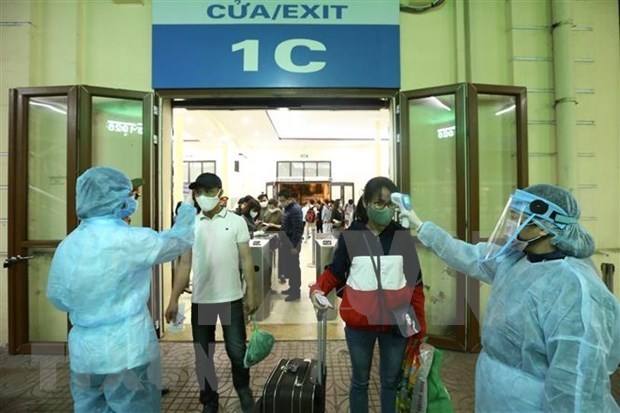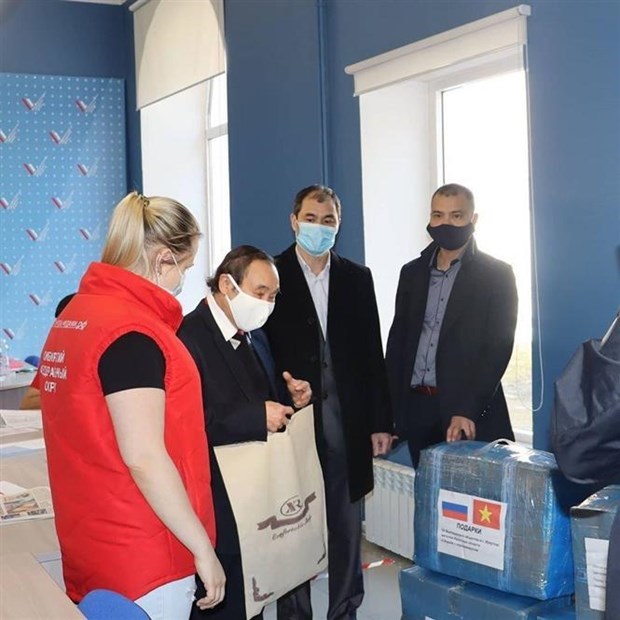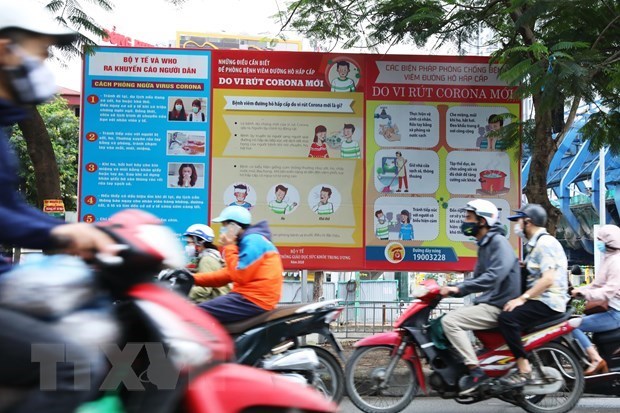The Government has classified localities into different risk groups and has ordered local authorities in areas deemed medium risk or low risk to follow developments of the pandemic and create the conditions needed to resume production and business. They are also able to determine which retail outlets can open. The decision has received warm support from the public.
No new cases have been recorded in Vietnam for seven consecutive days - proof that the introduction of social distancing measures has had the desired effect. Localities deemed medium risk or low risk can direct enterprises to resume production and business - a move backed by the population.
Many people have proposed continuing with preventive measures such as wearing masks, limiting the size of crowds, and regularly washing hands to keep the pandemic at bay and return to normality./.
French dailies praise Vietnam’s COVID-19 fight
|
Major French dailies have spoken highly of Vietnam’s efforts in the fight against COVID-19, noting that the country is “an exception”.
The Ouest-France daily noted that Vietnam, with a population of 96 million and 1,000 km of shared border with China, reported 270 COVID-19 infections as of April 24, with no deaths.
Vietnam was quick to take action, it said. Schools did not reopen after the Lunar New Year holiday in late January. The country’s border with China was closed from February 1, one week after the discovery of the first COVID-19 cases.
For each reported case, those who have been in direct or indirect contact with the patient will go into quarantine.
Advanced technology also has a role to play as citizens are encouraged to make medical declarations on a health reporting app, it wrote.
Wearing a mask has been made compulsory since the beginning of April and social distancing rules were put in place despite the low number of cases.
Another daily Le Monde published an article titled “Vietnam's successful ‘spring offensive’ against COVID-19”, saying it is the result of an effective policy for identifying and monitoring infected and at-risk people and groups.
In addition, people closely followed social distancing rules, it noted.
Refuting doubts on COVID-19 statistics in Vietnam, the daily quoted a Vietnamese-French tested positive for coronavirus and received treatment in Ho Chi Minh City as saying that since social networks are used widely in Vietnam, it is difficult for the Government to hide such a large-scale epidemic.
The Vietnamese Government recently offered 550,000 face masks for the five European nations of France, Germany, Italy, Spain and the UK, along with 800,000 others for the two neighbours of Laos and Cambodia.
Vietnam also handed over 450,000 Dupont protective suits to the US, it wrote.
Meanwhile, Les Echos noted that Vietnam does not apply costly large-scale screening tests, but carries out rapid identification and mandatory quarantine of infected people, as well as track of their contacts.
A mobile application, NCOVI, was launched on March 10 to encourage everyone to report their health condition and to be followed in the event of contact with an infected person, it added./.
UK newspaper highlights Vietnam’s contact-tracing strategy against COVID-19
 |
|
Passengers have their body temperature checked before entering Hanoi Train Station.
|
UK-based Telegraph called Vietnam “an under-reported success story of the pandemic” in an article published on April 23, given that the country had reported, by that time, just 268 cases and zero deaths.
Vietnam has started to lift the strict movement and social distancing restrictions that still remain in many of its Southeast Asian nations, allowing daily life in major cities to slowly come back to normal, the newspaper said.
The country of 95 million people has managed to keep the COVID-19 under control despite being less wealthy than other strong Asian performers like the Republic of Korea and Taiwan (China), and its 1,000-km porous border with China, it said.
Like its Asian countries, Vietnam’s swift response was based on a robust pandemic response plan that was forged after recent deadly brushes with other high-risk infectious diseases, including SARS and A/H5N1.
It highlighted the Vietnamese strategy, saying it focused on a combination of targeted, rigorous contact-tracing and testing to swiftly contain small clusters of the COVID-19 before they spread further.
After the first cases were confirmed in January, Vietnam quarantined more than 10,000 people in Son Loi commune in the northern province of Vinh Phuc after a smattering of infections. It also decided early on to impose a 14-day quarantine on anyone arriving in the country from a high-risk area while all schools and universities have been closed since the beginning of February, it noted.
“In March, when Vietnam’s 22-day disease-free run was broken by a cluster of imported cases linked to a flight from London, officials tracked down and quarantined all passengers, and suspended visa-free entry for the UK and several European countries,” the Telegraph said. “It later sealed off its borders.”
The newspaper also hailed Vietnam’s massive public information campaign on the pandemic, which included the hand-washing song "Ghen Co Vy" that went viral globally.
It quoted Dr John MacArthur, Thailand country director for the US Centres for Disease Control, as praising Vietnam’s response which was made possible by “strong public health systems, the whole-of-government approach” and a huge team of “disease detectives” to carry out contact tracing./.
Vietnamese community offers face masks for Russian city
 |
|
Head of the Vietnamese community in Irkutsk city Nguyen Quang Duong (second from left) presents the relief to local volunteers |
The Vietnamese community in Irkutsk city of Russia has donated 4,000 cloth face masks for a local voluntary campaign in support of the fight against COVID-19.
The campaign aims to support senior citizens, people with disabilities and medical workers in the wake of the global pandemic. It draws the participation of 2,000 volunteers in Irkutsk.
Receiving the aid, Acting Minister of Youth Policy in Irkutsk Oblast Egor Lukovnikov underlined that personal protective equipment is vital for volunteers as they are also on the frontlines of the combat and have to work every day.
There are about 250 Vietnamese citizens living in Irkutsk city./.
Hanoi Red Cross, group help 1,000 needy
The Hanoi Red Cross and the Phu Thai Group on April 25 started a two-day programme to help the local needy who are further suffering from the raging COVID-19 pandemic.
Their 1,000 relief aid packages include daily necessities, and their move is in response to the month for humanitarian activities this year.
Chairman of the Hanoi Red Cross Dao Ngoc Trieu said the activities of the month will focus on the care for community health, especially the disadvantaged who are struggling in the context of the pandemic. The official added that his organisation is striving to help from 5,000-7,000 needy in the month.
The same day, similar activities were conducted in other localities of Hanoi.
Since the beginning of February, Hanoi Red Cross organisations have provided over 930,000 face masks, nearly 55,000 bottles of sanitiser and soap, 404 million VND (17,250 USD) and nearly 400 tonnes of rice, among others, to the needy. They have attracted the participation of many companies and donors to the humanitarian work./.
US media highlights Vietnamese success in fighting COVID-19 pandemic
The Los Angeles Times of the United States recently published an article in which it gave an analysis of Vietnam’s successful efforts to halt the spread of the novel coronavirus (COVID-19) pandemic, noting that the country has not seen a single death caused by the virus, and is therefore starting to ease its lockdown measures.
The article said Vietnam has sealed its borders, quarantined masses of people, used soldiers and police to track down potential infections and fined social media users for spreading misinformation. After deploying the full arsenal, the sprawling nation of 95 million people has now gone a full week without recording a new infection.Vietnam mobilized the entire apparatus to become involved in the battle against the COVID-19 pandemic, which received wide response from the people.
But despite their effectiveness, Vietnam’s measures are not easily replicable. Its intolerance of dissent and ability to mobilize an entire security and political apparatus — steps more common in China — meant its campaign met little of the pushback seen in Western liberal democracies.
Starting on April 23, Vietnam allowed residents across the country to resume small gatherings and restarted buses, taxis and regular domestic flights for the first time in three weeks. But with much of Southeast Asia still under lockdown, people must continue wearing masks in public, gatherings of more than 20 remain off-limits, schools will stay closed for several more weeks and international flights are still grounded.
“The numbers are stunningly low considering that Vietnam — which shares a border with China — was among the first countries where the virus spread and lacks the resources of governments more celebrated for their containment strategies, such as South Korea’s widespread testing and Taiwan’s aggressive digital surveillance,” the article said.
Its results stand out even more as other Southeast Asian countries struggle. Wealthy Singapore, once regarded as a model, has seen infections skyrocket among migrant workers living in overcrowded dormitories. Indonesia, the largest country in the region, initially ignored the threat and now has the most COVID-19 deaths in Asia after China.
“It’s pretty amazing,” said Huong Le Thu, a senior analyst at the Australian Strategic Policy Institute. “I’m cautious of calling Vietnam a success story. It’s too early to be out of the woods. But the measures have been quite effective so far.”
Experts credit Vietnam’s early, decisive steps such as swiftly banning nearly all travel from China, suspending schools in mid-January even before recording any infections, quarantining tens of thousands of people, employing distancing measures and tracing the contacts of COVID-19 patients.
“Only a few countries can control and mobilize resources on this scale,” said Le Hong Hiep, a Vietnam analyst at the ISEAS-Yusof Ishak Institute in Singapore. “In Vietnam they can do it, and partly because of a political system that’s designed to respond to such situations. It’s not always good, but in a crisis it helps.”
In recent weeks, as imported infections surged across Asia, Vietnam placed tens of thousands of incoming travelers — whether they showed COVID-19 symptoms or not — in quarantine at army barracks, university dorms and other public facilities.
“What we know now is this virus spreads from pre-symptomatic people, and if you’re only monitoring people when they get symptoms it’s too late,” said Todd Pollack, a Harvard Medical School infectious disease specialist who leads a health initiative in Hanoi.
Meanwhile, results of a 12-country opinion poll by Ipsos Business Consulting showed that "Vietnam people have a general positive sentiment towards Vietnam state measures", its country head, Mr Phong Quach, told The Straits Times. In its March 12-14 survey, well over 80 per cent of Vietnamese respondents expected things to return to normal by June, making them more optimistic than respondents in the United States, Italy, France, Russia, Japan and India.
